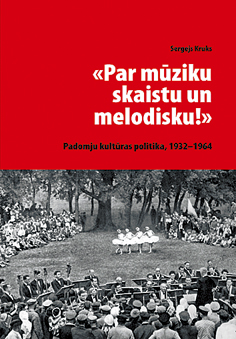|
|
 The Beauty of Soviet Music or what’s inside the Teddy Bear The Beauty of Soviet Music or what’s inside the Teddy Bear Gundega Laiviņa, Social Anthropology Student Sergejs Kruks. Par mūziku skaistu un melodisku (Rīga: Neputns, 2008) | |
| This monograph by Sergejs Kruks “Par mūziku skaistu un melodisku! Padomju kultūras politika, 1932–1964”(1), philosopher and expert in communication science, is pleasing first of all because it is a valuable contribution to the comparatively small number of original works in the field of social, political und humanitarian sciences in Latvia. Another intriguing aspect is the scope of the book – unmasking the aesthetics of Soviet music and providing an analysis of Soviet culture policy of a certain era as an integral part of “the mechanism for public communication, the education of citizens and socialization”. While surfing freely between the fields of political science, social science, semiotics, sociology and anthropology, Kruks gives an insight into the decisions, strategies and reactions of USSR and Soviet Latvian politicians, party members and professionals of the creative arts, variously described as reasonable and unreasonable, fruitful and fruitless, serious and absurd even to a comic level, as well as the seemingly endless fight of those in power against the ordinary citizens. As a result we have a modest but wide-ranging study of Latvian society in those days, which, to my mind, also reveals a definite link to Latvian taste for music, cultural practices and value systems of today. | |
 Sergejs Kruks. "Par mūziku skaistu un melodisku!": Padomju kultūras politika, 1932-1964.: Rīga, Neputns, 2008., 224 lpp.: il. | |
| The book becomes gripping because of the way the author effortlessly shifts between time periods, countries and former Soviet republics, with constant references to classic authors in philosophy and sociology as well. These shifts and references might complicate the reading in some parts, though in general they enrich the book, as this approach of Kruks does not allow for a dry academic style to creep in. So there is no need to be afraid of reading this book. On the contrary – this work is potentially attractive to a diverse range of readers: musicians and composers, policy makers and other interested parties, sociologists and anthropologists, historians and anyone else who may be fascinated by the relations between politics and the public of the time, the specific aspects and unifying features of art which are difficult to understand today, and, finally, the various elements which regulated and influenced the lives of our parents and our grandparents. In my opinion, the most significant value of this book is the analysis of society from the point of view of sociology and anthropology. For me, the most interesting part of it is the small chapter named “The Functionality of Culture”, where the author examines the symbolic and social capital of Soviet society which, at a time when “nobody could obtain anything anywhere” [citizens’ access to both products and services was severely restricted], was of enormous significance. As these phenomena were so widespread and unique in Soviet society, it would be very interesting to have a much more detailed study on this. The third chapter of the book is named “The Paradigms of Culture Sociology” and serves as an excellent summary of the facts included in the previous chapters, expounding on the subject of relations between power, art and society in a universal manner and beyond any time frame. The appendix of the book contains a wide range of documents and photos not only in support of the study, but also adding a dimension of reality and concreteness. It is definitely worth making the effort to read the documents, as some of them could even be compared to works of fiction for the complicated plot and the tension they contain. The artistic design of the book is magnificent. I hope that the other parts of the study, about theatre, cinema and the fine arts, will soon be also published in a book, thus providing a full picture of artistic developments in Soviet Latvia. (1) “Here’s to Music, Beautiful and Melodious! Soviet Culture Policy, 1932–1964” | |
| go back | |







